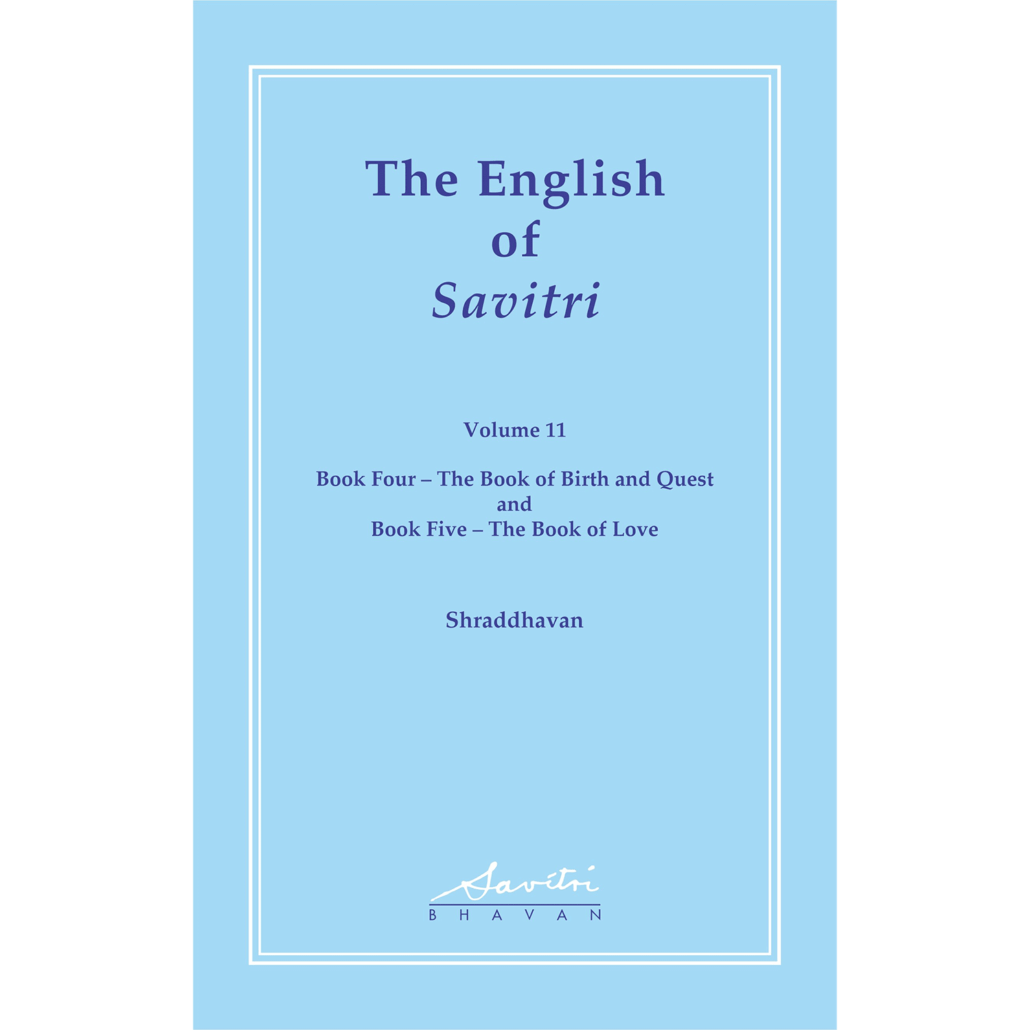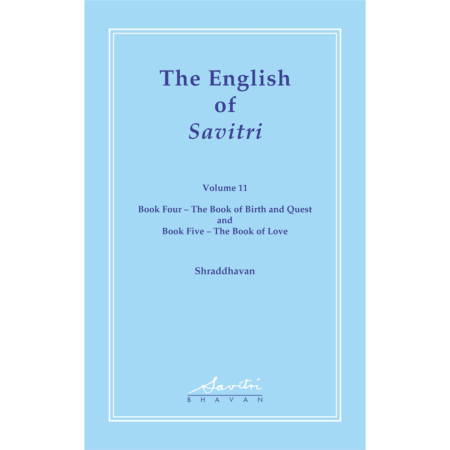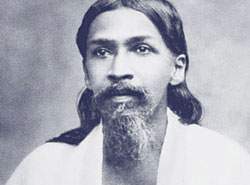The English of Savitri Volume 11

The English of Savitri
volume 11
Author: Shraddhavan
Print Length: 299 pages
Publisher: Savitri Bhavan
Book format: PDF, ePub, Kindle
Language: English
Book Download
Table of Contents
Introduction
Book Four – The Book of Birth and Quest
- Canto One – The Birth and Childhood of the Flame
- Canto Two – The Growth of the Flame
- Canto Three – The Call to the Quest
- Canto Four – The Quest
Book Five – The Book of Love
- Canto One – The Destined Meeting-Place
- Canto Two – Satyavan
- Canto Three – Satyavan and Savitri
Book Sample
The English of Savitri
volume 11
Sri Aurobindo’s epic poem Savitri is divided into three parts. We are about to start Part Two, which begins with the birth of Savitri and ends with the death of Satyavan. This is actually a very good place to start reading this poem. Once when we had a group of young Tamil teachers visiting Savitri Bhavan, they asked me to do the English of Savitri series for them, and I said we will not start with Book One, but with Book Four, because this is where the story of Savitri begins. The Part Two covers a lot of the legend part of the story. In a way it is much more accessible than Part One. Book Four, The Book of Birth and Quest, shows the birth of Savitri, her growing up, the kind of country she grew up in, and when she comes to maturity her father sending her out to travel the world to find her future husband, and her journey. Then we have Book Five, The Book of Love, wherein she actually meets Satyavan. Book Six, The Book of Fate, describes her return to the palace, the prophecy of Sage Narad that Satyavan must die in a year, and the whole drama of her parents urging her to choose someone else. But she insists, ‘“Once my heart chose and chooses not again”’. Then there is Book Seven, The Book of Yoga, which gives the whole yoga of Savitri in that one year of her life with Satyavan, when she has to prepare herself for the event of his death. And then comes Book Eight, The Book of Death, which closes with Yama, the god of death, coming and taking away the soul of Satyavan. That completes Part Two.
In this Eleventh Volume of The English of Savitri we cover Book Four, The Book of Birth and Quest and Book Five, The Book of Love. In these two Books we get to see many different aspects of Sri Aurobindo’s poetry: Nature poetry, Love poetry, enhanced with a whole series of very vivid imagery. There is an extraordinary richness to the way he describes the seasons of the year, the landscapes Savitri is passing by and the forest Satyavan lives in. And all the while he keeps reminding us of the spiritual significance of the story: Savitri’s birth, her growing-up years in the palace, her search for her destined life partner, and finally her meeting with Satyavan are all loaded with significance, not only for themselves, but for the humanity as a whole. For instance, the first meeting between Savitri and Satyavan, which is described in the last two cantos of Book Five, gives us a glimpse of a great spiritual experience a seeker can get. If we are following only the story, it is the narrative of a prince and a princess meeting in a picturesque location at the edge of a forest and falling in love at first sight. However, we cannot miss the deeper significance of this meeting. In his Author’s note Sri Aurobindo says “Satyavan is the soul carrying the divine truth of being within itself …” and “Savitri is the … goddess of the supreme Truth who comes down and is born to save;” In the way Satyavan introduces himself to Savitri we can see several allusions to this symbolism: how a glimpse, however brief, of the transcendent Truth can reveal so much and change the whole life of a sadhak. Every single line in that dialogue is loaded with a deeper significance, so we must be as receptive as we can to gain some insights.
All the visual treats awaiting us in these two Books and the flow of the mantra-like poetry will make our reading a great spiritual experience in itself. We get a closer look at nature through Sri Aurobindo’s eyes. In his own words “Sight is the essential poetic gift. The archetypal poet in a world of original ideas is, we may say, a Soul that sees in itself intimately this world and all the others, and God and Nature and the life of beings and sets flowing from its centre a surge of creative rhythm and word-images which become the expressive body of the vision; and the great poets are those who repeat in some measure this ideal creation, kavayah satyaśrutāh, seers and hearers of the poetic truth and poetic word.”
Keeping this in mind, let us now embark on our journey through these beautiful Books and see how much of that ‘poetic truth’ and ‘poetic word’ we can assimilate.




